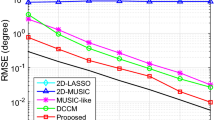Abstract
This paper deals with direction of arrival (DOA) and direction of departure (DOD) estimation of existing targets based on polynomial root finding estimators with minimum variance distortionless response (MVDR) criterion in bistatic multi-input multi-output radar systems. First, the presented estimator transforms the conventional two-dimensional searching approach into double one-dimensional polynomial root-MVDR approach for DOA and DOD estimation. Thus, the pairing operation can be obtained automatically. Second, to mitigate the influence of noise corruption and the estimate radial bias, we also presented a differential polynomial root-MVDR estimator to obtain more accuracy estimation performance. Finally, simulation results are provided to verify the efficiency of the proposed estimators.



Similar content being viewed by others
References
Bekkerman, I., & Tabrikian, J. (2006). Target detection and localization using MIMO radars and sonars. IEEE Transactions Signal Processing, 54(10), 3873–3883.
Li, J., & Stoica, P. (2009). Array signal processing for MIMO radar. UK: Wiley.
Yan, H., Li, J., & Liao, G. (2008). Multitarget identification and localization using bistatic MIMO radar systems. EURASIP Journal on Advances in Signal Processing, 48, 1–8.
Bencheikh, M. L., Wang, Y., & He, H. (2010). Polynomial root finding technique for joint DOA DOD estimation in bistatic MIMO radar. Signal Processing, 90(9), 2723–2730.
Jinli, C., Hong, S., & Weimin, S. (2008). Angle estimation using ESPRIT without pairing in MIMO radar. Electronics Letters, 44(24), 1422–1423.
Hsu, C. H., Liu, H. C., & Hua, M. C. (2014). Joint DOD–DOA estimation based on signal subspace approach in MIMO radars. Wireless Personal Communications, 77(2), 951–961.
Oh, D., Li, Y. C., Khodjaev, J., Chong, J. W., & Lee, J. H. (2015). Joint estimation of direction of departure and direction of arrival for multiple-input multiple-output radar based on improved joint ESPRIT method. IET Radar, Sonar and Navigation, 9(3), 308–317.
Bencheikh, M. L., & Wang, Y. (2010). Joint DOD–DOA estimation using combined ESPRIT-MUSIC approach in MIMO radar. Electronics Letters, 46(15), 1081–1083.
Zhang, X., & Xu, D. (2013). Angle estimation in bistatic MIMO radar using improved reduced dimension Capon algorithm. Journal of Systems Engineering and Electronics, 24(1), 84–89.
Zhang, X., Xu, L., Xu, L., & Xu, D. (2010). Direction of departure (DOD) and direction of arrival (DOA) estimation in MIMO radar with reduced-dimension MUSIC. IEEE Communication Letters, 14(12), 1161–1163.
Zheng, G. (2014). Beamspace root-MUSIC algorithm for joint DOD DOA estimation in bistatic MIMO radar. Wireless Personal Communications, 75(4), 1879–1889.
Li, J., & Zhang, X. (2014). Unitary subspace-based method for angle estimation in bistatic MIMO radar. Circuits, Systems, and Signal Processing, 33(2), 501–513.
Zheng, G., & Chen, B. (2015). Unitary dual-resolution ESPRIT for joint DOD and DOA estimation in bistatic MIMO radar. Journal of Multidimensional Systems and Signal Processing, 26(1), 159–178.
Chang, A. C., Shen, C. C., & Chang, K. S. (2014). DOA and DOD estimation using orthogonal projection approach for bistatic MIMO radars. IEICE Transactions on Fundamentals of Electronics, Communications, and Computer Sciences, 97(5), 1121–1124.
Chang, A. C., Hsu, C., & Su, I. J. (2007). Robust MVDR beamforming via polynomial rooting calibration for CDMA signals. IEICE Transactions on Communications, 90(11), 3298–3302.
Van Trees, H. L. (2002). Optimum array processing. New York: Wiley.
Golub, G. H., & van Loan, C. H. (1996). Matrix computations. Baltimore, MD: The Johns Hopkins University Press.
Acknowledgments
The authors would like to thank the anonymous reviewers for their valuable and constructive comments, which helped to improve the presentation of the paper. This research was supported by the Ministry of Science and Technology under grant number MOST 104-2221-E-275-006.
Author information
Authors and Affiliations
Corresponding author
Rights and permissions
About this article
Cite this article
Chen, SW., Meng, CL. & Chang, AC. DOA and DOD Estimation Based on Double 1-D Root-MVDR Estimators for Bistatic MIMO Radars. Wireless Pers Commun 86, 1321–1332 (2016). https://doi.org/10.1007/s11277-015-2991-0
Published:
Issue Date:
DOI: https://doi.org/10.1007/s11277-015-2991-0




